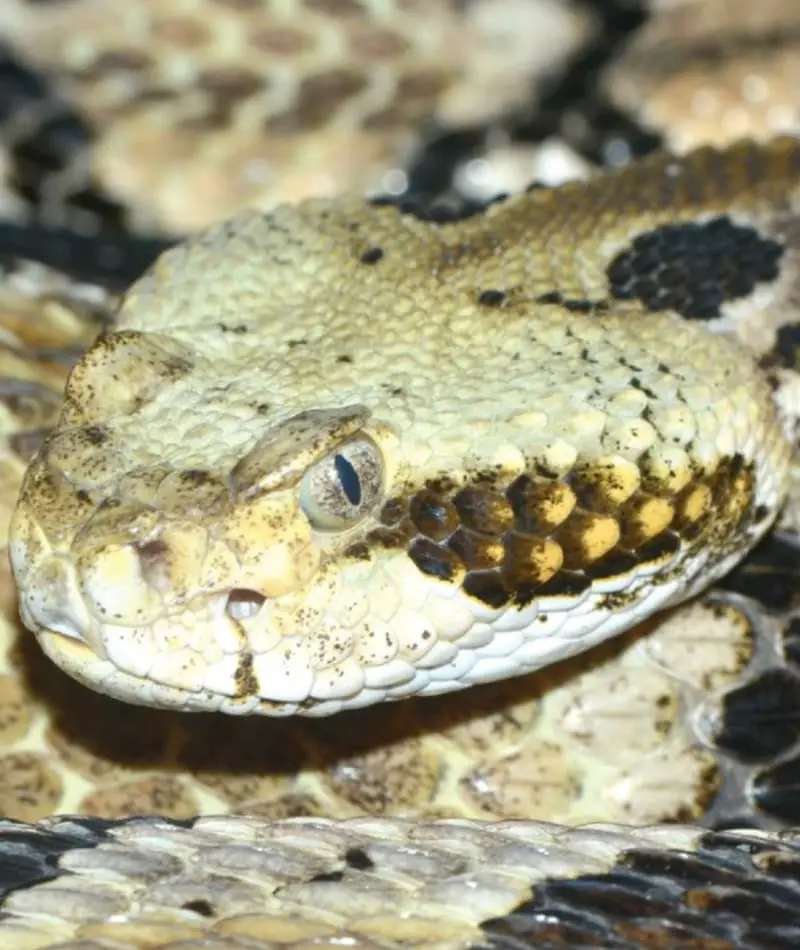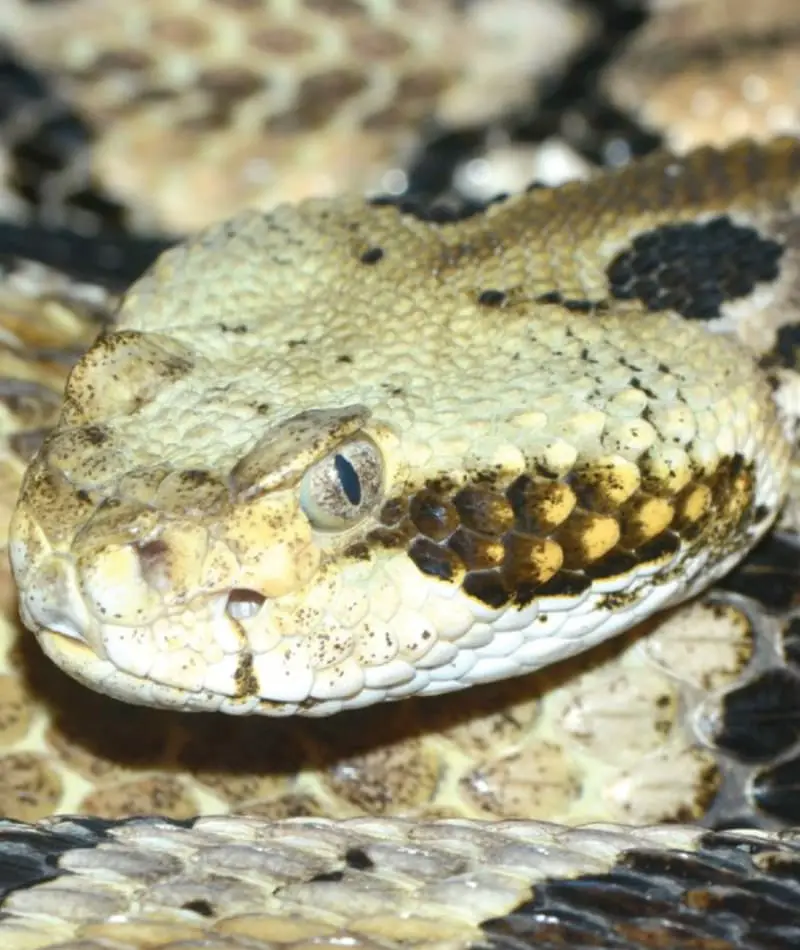The Timber Rattlesnake, also known as the Canebrake Rattlesnake, is a venomous species of snake found in the eastern United States. It is a fascinating creature that has captured the attention of many people because of its distinctive rattling sound.
With its impressive length of up to six feet and unique pattern of dark brown or black bands on a gray or yellowish background, the Timber Rattlesnake is a sight to behold. But what is it about this snake that makes it so intriguing, and why is it important to understand its behavior and habitat? Let’s explore the world of the Timber Rattlesnake.
A Timber Rattlesnake is a venomous species of snake found in North America. It is easily recognizable by its brown or grayish color with dark bands or blotches on its body. It can grow up to 6 feet in length and has a distinctive rattle at the end of its tail, which it uses as a warning when it feels threatened. Timber Rattlesnakes are important predators in their ecosystem and play a crucial role in controlling rodent populations.

What is a Timber Rattlesnake?
The timber rattlesnake, also known as the canebrake rattlesnake, is an impressive reptile that belongs to the pit viper family. It is named after its habitat, which is primarily forested areas with abundant timber. This venomous snake is found in the eastern part of North America and is known for its distinctive rattling sound, which is produced by the rattles at the end of its tail.
Physical Characteristics
The timber rattlesnake is a large and robust snake, with an average length of 3-5 feet. It has a triangular-shaped head and its body is covered with keeled scales. The color of its skin varies from yellowish-brown to grayish-brown, with dark brown or black bands or blotches running down the length of its body. The timber rattlesnake also has a rattle at the end of its tail, which it uses to warn potential predators.
Timber rattlesnakes are sexually dimorphic, with males being larger than females and having longer tails. They are also known for their heat-sensing pits, which allow them to detect the presence of prey and predators.
Habitat and Distribution
Timber rattlesnakes are found primarily in forested areas, including deciduous and mixed forests, as well as rocky outcrops and mountainous areas. They are also found in swamps, marshes, and other wetland areas.
The timber rattlesnake’s range extends from the southeastern part of Canada to the northeastern part of Mexico, including the eastern half of the United States. They are most commonly found in the Appalachian Mountains, but can also be found in other parts of the country, such as the Ozarks and the Great Lakes region.
Diet
Timber rattlesnakes are carnivores and feed primarily on small mammals such as mice, voles, and rabbits. They also eat birds, lizards, and other snakes. Timber rattlesnakes are ambush predators, meaning that they wait in one spot for their prey to come to them.
When hunting, timber rattlesnakes use their heat-sensing pits to detect the presence of prey. They then strike with lightning-fast speed, injecting their venom into their prey. The venom of the timber rattlesnake is highly toxic and can cause severe pain, swelling, and even death in some cases.
Behavior
Timber rattlesnakes are solitary animals that are most active during the day in the spring and fall, and at night during the summer. They hibernate in the winter and emerge from their dens in the spring to mate and feed.
Timber rattlesnakes are known to be docile animals, but they will defend themselves if threatened. When threatened, they will coil up and shake their rattle, warning potential predators to stay away. If the threat persists, they will strike with their fangs and inject their venom.
Conservation Status
The timber rattlesnake is listed as a threatened species in some states and is protected by law in others. Habitat loss, persecution by humans, and collection for the pet trade are the primary threats to the timber rattlesnake’s survival.
Conservation efforts are underway to protect the timber rattlesnake and its habitat. These efforts include habitat restoration, education and outreach programs, and research to better understand the biology and behavior of the species.
Benefits and Risks
The timber rattlesnake plays an important role in its ecosystem as a predator, helping to control populations of rodents and other small mammals. However, its venom can be dangerous to humans and pets, and it should be treated with respect and caution.
If you encounter a timber rattlesnake in the wild, it is important to give it plenty of space and avoid disturbing it. If you are bitten by a timber rattlesnake, seek medical attention immediately.
In conclusion, the timber rattlesnake is a fascinating and important species that plays a vital role in its ecosystem. While it is important to be aware of the risks associated with this venomous snake, it is also important to appreciate its beauty and unique characteristics.
Frequently Asked Questions
Timber Rattlesnakes are a type of venomous snake found in North America. They are known for their distinctive rattling sound, which they use as a warning to potential predators. Here are some common questions and answers about Timber Rattlesnakes:
How can I identify a Timber Rattlesnake?
Timber Rattlesnakes are typically large, with adults ranging from 3 to 5 feet in length. They have a triangular-shaped head and a thick body. Their coloration can vary, but they usually have brown or grayish-brown scales with dark bands or blotches. The tail ends in a rattle, which is a series of interlocking segments that make a distinctive rattling sound when the snake feels threatened.
It’s important to note that there are other species of rattlesnakes found in North America, so it’s important to be familiar with the specific characteristics of Timber Rattlesnakes to avoid confusion.
Where do Timber Rattlesnakes live?
Timber Rattlesnakes are found in the eastern and central United States, from Minnesota to Texas and from Florida to New Hampshire. They prefer wooded areas, especially those near rocky outcrops or ledges, which provide shelter and basking spots. They can also be found in grassy fields, but they generally avoid open areas.
Timber Rattlesnakes are not typically found in highly urbanized areas, but they can sometimes be found in suburban or rural areas near forests or other natural habitats.
What do Timber Rattlesnakes eat?
Timber Rattlesnakes are carnivorous and primarily eat small mammals such as mice, rats, and squirrels. They may also eat birds, amphibians, and other snakes. They use their venom to subdue their prey, injecting it through their fangs and then waiting for the prey to die before consuming it.
It’s important to note that Timber Rattlesnakes play an important role in their ecosystem by helping to control rodent populations, which can be harmful to crops and other wildlife.
Are Timber Rattlesnakes dangerous?
Timber Rattlesnakes are venomous and can be dangerous to humans. Their venom can cause pain, swelling, and even death in some cases. However, they are generally not aggressive and will usually try to avoid humans if possible. Most bites occur when people accidentally step on or otherwise disturb a hidden or camouflaged snake.
If you encounter a Timber Rattlesnake, it’s important to give it plenty of space and avoid disturbing it. If you are bitten, seek medical attention immediately.
Are Timber Rattlesnakes protected?
Timber Rattlesnakes are protected in many states and are listed as a threatened or endangered species in some areas. This is due to habitat loss, persecution by humans, and other factors. It is illegal to kill or harm Timber Rattlesnakes in many states, and in some cases, permits may be required to handle or relocate them.
If you encounter a Timber Rattlesnake, it’s important to remember that they are a valuable part of their ecosystem and should be treated with respect and caution.
The Timber Rattlesnake: Everything You Need To Know! (4K)
In conclusion, the Timber Rattlesnake is a fascinating and unique species of rattlesnake that can be found throughout the eastern United States. They are known for their distinctive rattling sound and are highly venomous, making them both feared and respected by many. Despite their dangerous reputation, the Timber Rattlesnake plays an important role in their ecosystem and is a valuable part of the natural world.
As with many species of wildlife, the Timber Rattlesnake faces a number of threats to its survival. Habitat loss, disease, and human persecution are all major challenges that they must overcome in order to thrive. However, with the help of conservation efforts and education, we can work to protect and preserve this amazing species for generations to come.
In the end, the Timber Rattlesnake serves as a reminder of the intricate and interconnected nature of the natural world. By learning about and appreciating these incredible creatures, we can gain a greater appreciation for the diversity and complexity of life on our planet.


